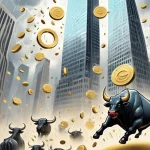USD1 Stablecoin Skyrockets 1,540%: Can It Hold Its Dollar Peg Amid Rivals?

USD1 Stablecoin Surges 1,540%: Can It Maintain Its Peg Amidst Competition?
The USD1 stablecoin, launched by World Liberty Financial Inc. (WLFI) with ties to former U.S. President Donald Trump, has seen its market capitalization skyrocket from $128 million to over $2.1 billion in just a week. This meteoric rise, fueled by a $2 billion investment from Abu Dhabi’s MGX, positions USD1 as a significant player in the $231 billion stablecoin market. However, with political affiliations and fierce competition from giants like Tether and Circle, maintaining its 1:1 peg to the U.S. dollar is a formidable challenge.
- USD1’s market cap surged 1,540% in under a week.
- $2 billion investment from MGX drives growth.
- USD1 struggles to maintain peg amidst competition.
USD1’s rapid ascent can be traced back to massive token mints on the Binance Smart Chain (BSC), where some transactions exceeded $90 million between late April and early May 2025. Token mints refer to the creation of new tokens on a blockchain, similar to issuing new shares in a company. This surge was significantly boosted by a $2 billion investment from MGX, an Abu Dhabi-based firm, which plans to use USD1 to settle its investment in Binance, a major cryptocurrency exchange. Launched in April 2025, WLFI’s stablecoin aims to maintain a stable 1:1 peg to the U.S. dollar, backed by a portfolio including short-term U.S. Treasuries, USD bank deposits, and cash equivalents.
Despite its global appeal, with nearly 90% of its investor base located outside the U.S., primarily in Europe, Asia, and Latin America, USD1 faces stiff competition. Over 99% of its total supply sits on Binance’s BNB Chain, with a smaller share on Ethereum. In a market dominated by the likes of Tether (USDT) and Circle (USDC), maintaining a stablecoin’s peg is like trying to keep a toddler from running into traffic – challenging and unpredictable. Keeping a peg means ensuring the stablecoin retains a fixed exchange rate with the dollar, which is crucial for its credibility and use as a reliable medium of exchange.
WLFI has been proactive in promoting USD1. A community vote to airdrop USD1 to $WLFI holders garnered a whopping 99.97% approval, showcasing strong community support. Additionally, listings on centralized exchanges like HTX have further bolstered its visibility. Since its launch, WLFI has raised an impressive $550 million, signaling its ambition to challenge the stablecoin giants. However, the road ahead is fraught with challenges. The political affiliations with Donald Trump have drawn scrutiny, with Democratic Senator Elizabeth Warren raising concerns about potential conflicts of interest and corruption. With the GENIUS Act pending, which aims to regulate stablecoins, USD1’s future could be influenced by regulatory shifts as much as market dynamics.
The integration of USD1 into the Tron blockchain, backed by significant investment from Justin Sun, adds another layer of complexity. While this move expands USD1’s reach, it also raises questions about the sustainability of its rapid growth, especially given that an anonymous wallet holds $2 billion worth of the stablecoin, and the owner remains a mystery. It’s like watching a high-stakes poker game where the biggest player is wearing a mask.
While some see USD1 as a game-changer, others caution that its rapid growth might be a bubble waiting to burst. The reliance on a single large investor and the political affiliations could pose significant risks. It’s crucial for investors to consider these factors and not get swept up in the hype. As the saying goes, don’t let the FOMO (Fear Of Missing Out) cloud your judgment.
USD1’s emergence aligns with the principles of effective accelerationism, pushing the boundaries of financial innovation and challenging traditional systems. While it may not be a direct competitor to bitcoin, it contributes to the broader narrative of decentralization and disruption in the financial sector. Bitcoin remains the bedrock of the entire ecosystem, but altcoins like USD1 push the boundaries of what’s possible, filling niches that bitcoin itself might not serve well.
Despite the hurdles, the future of decentralized finance looks bright with innovations like USD1. But let’s not kid ourselves – the Trump connection is a double-edged sword that could either propel USD1 to new heights or drag it down into controversy. It’s a rollercoaster ride, and we’re all strapped in for the journey.
Key Takeaways and Questions
- What is the current market capitalization of USD1?
Over $2.1 billion.
- What was the percentage increase in USD1’s market capitalization in less than a week?
1,540%.
- What drove the surge in USD1’s market capitalization?
A $2 billion investment deal from MGX, an Abu Dhabi-based firm, planning to use USD1 to settle its investment in Binance.
- Who issued the USD1 stablecoin?
World Liberty Financial Inc. (WLFI).
- What is the intended peg of USD1?
A 1:1 peg to the U.S. dollar.
- What assets back USD1?
Short-term U.S. Treasuries, USD bank deposits, and cash equivalents.
- Where is the majority of USD1’s investor base located?
Outside the United States, primarily in Europe, Asia, and Latin America.
- On which blockchain does most of USD1’s supply reside?
Binance’s BNB Chain.
- What is the total market size of the stablecoin market?
$231 billion.
- What are the dominant stablecoins in the market?
Tether (USDT) and Circle (USDC).
- What is WLFI’s strategy to promote USD1?
Launching a community vote for an airdrop to $WLFI holders and listing on centralized exchanges like HTX.
- How much has WLFI raised since its launch in 2024?
$550 million.
- What challenges does USD1 face in maintaining its peg?
Competition from established stablecoins like Tether and Circle, and concerns over its political affiliations and rapid expansion.



